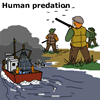|
Impacts on environments: Human
Prehistoric Man lived essentially in balance with nature, as both predator
and prey in the food web.
Since then the human population has grown dramatically due to industrialisation
and mechanised farming practices creating more food, and improvements
in health and nutrition increasing life expectancy.
The effects of overpopulation on the Earth's environment, however,
are causing extinction of species at an alarming rate. These many effects
include:
|
Hunting and over-fishing
Mechanised "predation techniques" (guns, nets, and trapping)
decimate animal populations directly, and indirectly affect other
organisms in the food chain.
Indiscriminate netting also kills undersize fish (reducing future
breeding), as well as wasting non-commercial species important
in the food chain.
|
 |
|
Mining
Habitat destruction through land clearing and road building destroys
nesting areas and food sources.
Chemical pollution from ore refining processes kills many species.
|
 |
Farming and logging
Clearing of land, and farming practices, impact on the environment in
many ways.
- Extensive land clearing destroys natural habitats and affects global
climate (tropical rainforest destruction is altering global rainfall
due to reduced transpiration).
- Planting of introduced single species (either crops or plantation
trees) decreases
biodiversity and increases food for pests.
- Over-grazing causes erosion and loss of topsoil.
- Indiscriminate pesticide spraying effects natural pollination.
Chemicals can accumulate in higher order consumers (see Eat
and be eaten: food chains) e.g. DDT passed through food chain
builds up to lethal levels in birds ultimately effecting strength
of egg shells and survival of young.
- Land clearing and over-irrigation cause salinity and rise in water
tables e.g. loss of
orchards in the Goulburn Valley.
- Controlled flooding affects natural breeding cycles in wetland
birds.
- Fertilisers washed into streams cause algal blooms which
in turn deplete oxygen supplies in streams.
-
Land mismanagement has increased desertification, claiming
70,000 sq.km per year throughout the world.
|
|
Urbanisation
- Damaging levels of air and water pollution result from high density
urban developments.
- Burning fossil fuels (cars and factories) increases carbon dioxide
levels resulting in
global warming from the The
greenhouse effect.
- Sulphur dioxide exhausts cause acid rain, killing some species
and causing corrosion.
- Higher fluorocarbon levels damage the ozone layer, increasing UV
radiation resulting in
higher incidence of skin cancers.
- Smog aggravates human respiratory problems.
- Use of river water for industrial cooling of machines in factories
increases temperature of the rivers, thereby killing aquatic life
from decreased oxygen availability.
- Clearing of surrounding bushland to accommodate the "suburban
sprawl" destroys natural habitats.
- Domestic pets compete with natural organisms, and sometimes turn
"feral", killing many native species.
- Sewage treatment and rubbish removal can cause major environmental
problems, but recycling can reduce the need for landfill areas
and save resources especially for non-biodegradable materials.
- Nuclear wastes are particularly damaging to living things.
|
|
Recreational activities
- Off-road driving causes soil erosion, destruction of native flora
and frightening of fauna.
- Increased access to "wilderness" areas by 4 WD vehicles
threatens isolated fish breeding areas and fauna "havens".
- Aquatic motor sports cause pollution through oil spills.
- Campers can damage animals' hollows through firewood collection,
and bushfires can be started by lack of care. Wastes products can
pollute streams.
- Seeds of noxious weeds are spread by boots or tyres.
Burning activities
Slash-burning forms of agriculture on a large scale can cause considerable
smoke, reduced visibility, and alter local weather patterns.
Introduced species
- Plants and animals introduced into a different area often lack
natural predators and soon become very prolific and jeopardise survival
of native species (see Introduced species: "Not in my backyard").
- Ease of global travel has necessitated quarantine restrictions
to prevent accidental or deliberate introduction of foreign species.
Some marine species have been introduced in the bilge water of ships.
No-one is an island... our actions have serious wide-ranging
repercussions.
|